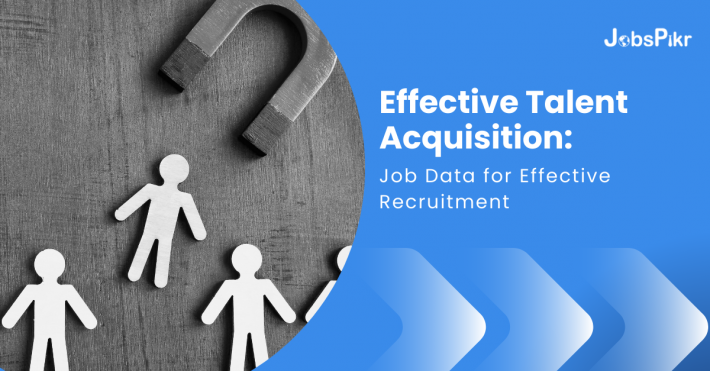In today’s competitive job market, talent acquisition has evolved into a complex, data-driven process. Companies that use data effectively can gain a significant edge in recruiting top talent. This article explores how organizations can leverage job data for effective talent acquisition, including strategies for data-driven recruitment and candidate assessment.
Importance of Job Data in Talent Acquisition
Talent acquisition is no longer about simply posting a job ad and waiting for applications to pour in. Modern recruitment requires a strategic approach, and job data plays a crucial role in this transformation. which encompasses a wide range of information, including:
– Job market trends: Insights into which skills and roles are in high demand.
– Candidate profiles: Detailed information about potential candidates’ qualifications, experience, and preferences.
– Recruitment metrics: Data on time-to-hire, cost-per-hire, and the effectiveness of various recruitment channels.
– Employee performance: Information on how current employees perform in their roles, which can help predict the success of future hires.
Harnessing this data allows companies to make informed decisions, streamline their recruitment processes, and ultimately attract the best candidates.

Source: LinkedIn
Data-Driven Talent Acquisition Strategies
1. Leveraging Job Market Trends
Understanding job market trends is essential for effective talent acquisition. Companies can use data to identify which skills are in high demand and anticipate future hiring needs. This proactive approach enables organizations to stay ahead of the competition.
– Industry Analysis: Regularly analyzing industry-specific job data helps identify emerging trends and skill gaps. For example, the rise of artificial intelligence (AI) and machine learning (ML) has created a surge in demand for data scientists and AI specialists.
– Geographical Insights: These data can reveal regional trends, such as which locations have a high concentration of certain skills. This information can guide decisions on where to focus recruitment efforts.
2. Enhancing Candidate Sourcing
Effective candidate sourcing is about finding the right talent quickly and efficiently. Job data can improve this process in several ways:
– Predictive Analytics: By analyzing historical recruitment data, companies can predict where they are likely to find the best candidates. For instance, if data shows that a particular university consistently produces high-performing graduates, it may be worth establishing stronger connections with that institution.
– Social Media and Job Boards: Data from social media platforms and job boards can help identify where potential candidates are most active. This allows recruiters to target their efforts more precisely.
3. Optimizing Job Descriptions
Job descriptions play a critical role in attracting the right candidates. By analyzing the data, companies can craft more effective job postings:
– Keyword Optimization: Using data to identify which keywords are most effective in attracting qualified candidates can improve the visibility of job postings.
– Clarity and Precision: Analyzing successful job postings can reveal patterns in how they are structured. Clear, concise, and well-defined job descriptions tend to attract better candidates.
4. Improving Candidate Assessment
Assessing candidates accurately is vital to making the right hiring decisions. Job data can enhance this process through:
– Skill Matching: By comparing candidates’ profiles with job requirements, companies can identify the best matches. This data-driven approach reduces the likelihood of hiring mismatches.
– Performance Predictors: Analyzing data from current employees can help identify traits and skills that correlate with high performance. This information can be used to develop more effective assessment criteria for new hires.
5. Streamlining the Recruitment Process
A streamlined recruitment process is more efficient and cost-effective. Job data can help identify bottlenecks and areas for improvement:
– Time-to-Hire Analysis: By tracking time-to-hire metrics, companies can identify stages in the recruitment process that cause delays and implement strategies to expedite them.
– Cost-per-Hire Metrics: Understanding the cost associated with different recruitment channels enables companies to allocate their budgets more effectively.
Implementing a Data-Driven Recruitment Strategy
To harness the power of job data effectively, companies need to implement a comprehensive data-driven recruitment strategy. Here are key steps to consider:
1. Invest in the Right Technology
Technology plays a critical role in collecting, analyzing, and utilizing job data. Investing in advanced recruitment software and tools can streamline the data-driven recruitment process:
– Applicant Tracking Systems (ATS): Modern ATS platforms offer robust data analytics capabilities, enabling recruiters to track and analyze various metrics throughout the recruitment process.
– HR Analytics Tools: Specialized HR analytics tools can provide deeper insights into job data, helping companies make more informed decisions.
2. Develop a Data-Driven Culture
Creating a data-driven culture within the recruitment team is essential for success. This involves:
– Training and Development: Providing training on data analysis and interpretation to recruitment staff ensures they can leverage job data effectively.
– Encouraging Collaboration: Promoting collaboration between HR, recruitment, and job data analytics teams can foster a more holistic approach to data-driven talent acquisition.
3. Establish Clear Metrics and KPIs
Defining clear metrics and key performance indicators (KPIs) is crucial for measuring the success of data-driven recruitment efforts. Some important metrics to consider include:
– Time-to-Hire: The average time taken to fill a position.
– Cost-per-Hire: The total cost involved in hiring a new employee.
– Quality of Hire: The performance and retention rates of new hires.
4. Continuously Monitor and Adjust
The recruitment landscape is constantly evolving, so it’s important to continuously monitor and adjust your data-driven strategies:
– Regular Data Reviews: Conducting regular reviews of recruitment data helps identify trends and areas for improvement.
– Feedback Loops: Implementing feedback loops with new hires and hiring managers can provide valuable insights into the effectiveness of recruitment processes and candidate assessment methods.

Source: LinkedIn
In today’s competitive job market, leveraging data-driven approaches in talent acquisition has become essential for organizations aiming to attract, hire, and retain top talent. Now, let’s explore some brand-based case studies that illustrate success stories in data-driven talent acquisition.
Case Studies: Success Stories in Data-Driven Talent Acquisition
1. Google: Leveraging Data for Predictive Hiring
Google is renowned for its data-driven approach to talent acquisition. The company uses sophisticated algorithms to analyze job data and predict the success of potential hires. By examining factors such as academic performance, interview scores, and job performance data, Google can identify candidates who are likely to excel in their roles. This predictive hiring approach has contributed to Google’s reputation as a top employer and its ability to attract world-class talent.
2. IBM: Using Data to Enhance Diversity and Inclusion
IBM has harnessed job data to improve diversity and inclusion in its recruitment process. By analyzing data on candidate demographics, IBM identified patterns and potential biases in its hiring practices. The company then implemented strategies to address these issues, such as diverse interview panels and inclusive job descriptions. This data-driven approach has helped IBM build a more diverse and inclusive workforce, leading to better business outcomes.
The Future of Job Data in Talent Acquisition
As technology continues to advance, the role of job data in talent acquisition will only become more significant. Emerging trends and technologies, such as artificial intelligence (AI) and machine learning (ML), are set to revolutionize the recruitment landscape:
AI and Machine Learning
AI and ML algorithms can analyze vast amounts of job data quickly and accurately. These technologies can identify patterns and insights that would be impossible for humans to detect, enabling more precise candidate matching and assessment.
Predictive Analytics
Predictive analytics will play a crucial role in anticipating future hiring needs and identifying potential candidates. By analyzing historical job data, companies can forecast talent requirements and develop proactive recruitment strategies.
Blockchain for Secure and Transparent Hiring
Blockchain technology has the potential to enhance the transparency and security of the recruitment process. By creating tamper-proof records of candidates’ qualifications and work history, blockchain can reduce fraud and improve trust between employers and candidates.
Conclusion
Harnessing the power of job data is essential for effective talent acquisition in today’s competitive job market. By leveraging these data, companies can make more informed decisions, streamline their recruitment processes, and attract top talent. Implementing a data-driven recruitment strategy involves investing in the right technology, developing a data-driven culture, establishing clear metrics, and continuously monitoring and adjusting strategies. As technology continues to evolve, the role of data in talent acquisition will become even more critical, paving the way for innovative approaches and more successful hiring outcomes. Jobspikr can help by providing comprehensive and relevant job data to support these data-driven recruitment efforts, sign up for a demo.
FAQ
What are some key types of job data used in talent acquisition?
- Job Market Trends: Information on which skills and roles are in high demand.
- Industry Analysis: Identifying emerging skills and roles within specific industries.
- Geographical Insights: Understanding regional trends to focus recruitment efforts in high-talent areas.
- Candidate Profiles: Detailed data about candidates’ qualifications, experience, and preferences.
- Educational Background: Degrees, certifications, and institutions attended.
- Professional Experience: Past job roles, industries, and employment duration.
- Skills and Competencies: Specific skills and proficiency levels.
- Preferences and Interests: Preferred job types, work environments, and career aspirations.
- Recruitment Metrics: Data on time-to-hire, cost-per-hire, and recruitment channel effectiveness.
- Time-to-Hire: Average time taken to fill a position.
- Cost-per-Hire: Total cost of the recruitment process.
- Source Effectiveness: Success rates of various recruitment channels.
- Candidate Drop-off Rates: Points in the process where candidates drop out.
- Employee Performance: Insights into current employees’ performance to predict future hires’ success.
- Performance Reviews: Regular evaluations highlighting strengths and improvement areas.
- Productivity Metrics: Measures of output and efficiency.
- Retention Rates: Length of employee tenure and factors influencing it.
- Career Progression: Tracking development and progression within the organization.



